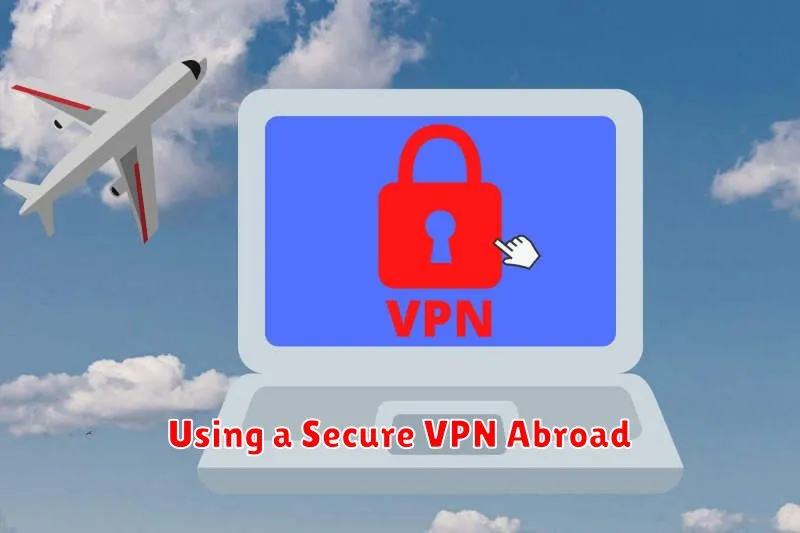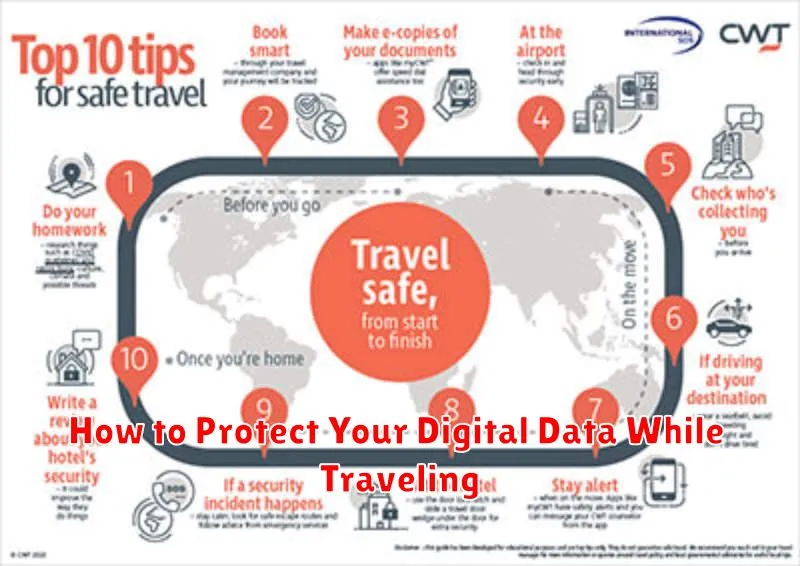Traveling often involves connecting to public Wi-Fi, using unfamiliar devices, and carrying sensitive digital data. This makes travelers particularly vulnerable to cybersecurity threats like data breaches, identity theft, and malware infections. Learning how to protect your digital data while traveling is crucial to ensuring a safe and enjoyable trip, whether for business or leisure. This article provides practical tips and strategies to safeguard your online privacy and keep your valuable information secure while you’re on the go. We’ll cover essential steps such as using strong passwords, enabling two-factor authentication, and recognizing phishing scams.
From understanding the risks of using public Wi-Fi hotspots to securing your devices and utilizing VPN services, this guide offers comprehensive advice on how to protect your digital data while traveling. Implementing these security measures will help mitigate the risks associated with accessing the internet abroad and ensure your personal information remains confidential. Learn how to travel smart and protect yourself from digital threats by following these simple yet effective recommendations for enhanced data security.
Digital Risks for Travelers
Travelers face an increasing array of digital risks while abroad. Data breaches are a significant concern, with unsecured Wi-Fi networks in hotels, cafes, and airports posing a threat to sensitive information like passwords and credit card details. Malware infections can occur through malicious links or downloads, compromising devices and potentially leading to identity theft. Furthermore, physical device loss or theft can expose personal data and leave travelers vulnerable to various cybercrimes.
Mitigating these risks requires proactive measures. Using a Virtual Private Network (VPN) encrypts internet traffic and protects data on public Wi-Fi. Strong, unique passwords for each online account are crucial, and enabling two-factor authentication adds an extra layer of security. Travelers should also be cautious about clicking on unfamiliar links or downloading files from untrusted sources. Regularly backing up data and ensuring devices are updated with the latest security patches is also essential.
Before embarking on a trip, travelers should inform their bank and credit card companies of their travel dates and destinations to prevent fraudulent activity alerts. It’s also wise to research local scams and cybercrime trends in the destination country. Finally, having a plan for reporting lost or stolen devices, including contact information for banks and mobile providers, is crucial for a quick response in case of an incident.
Using a Secure VPN Abroad

Traveling abroad often means connecting to unfamiliar Wi-Fi networks, which can pose significant security risks. Using a secure VPN is a crucial step to protect your online privacy and data while traveling. A VPN encrypts your internet traffic, making it much more difficult for hackers to intercept sensitive information like passwords, banking details, and personal communications. It also masks your IP address, making it appear as though you are browsing from a different location, which can be useful for bypassing geo-restrictions on certain websites or streaming services.
When choosing a VPN for international travel, prioritize providers with a strict no-logs policy. This ensures that your online activity isn’t being tracked or stored. Look for features like strong encryption protocols (such as AES-256), a kill switch (which automatically cuts off your internet connection if the VPN drops), and a wide range of server locations. Having multiple server options allows you to connect to a server in your desired location for optimal speed and access to region-specific content.
It’s important to install and configure your VPN before you depart on your trip. This ensures you’re protected from the moment you connect to a foreign network. Research local regulations regarding VPN usage in your destination country as some countries have restrictions. Once you arrive, simply connect to your chosen VPN server and browse with added peace of mind knowing your online activities are shielded from prying eyes.
Avoiding Public Wi-Fi Dangers
Public Wi-Fi hotspots are convenient, but they come with significant security risks. Because these networks are often open and unencrypted, malicious actors can potentially intercept your data. This includes sensitive information like passwords, credit card numbers, and personal details. To mitigate these risks, avoid accessing sensitive accounts like banking or email on public Wi-Fi. If you must use public Wi-Fi, consider using a virtual private network (VPN). A VPN encrypts your internet traffic, creating a secure connection even on unsecured networks.
Another key risk associated with public Wi-Fi is the potential for man-in-the-middle (MITM) attacks. In a MITM attack, a hacker intercepts communication between you and a legitimate website. They can then steal your data or redirect you to a fake website designed to phish your credentials. Be wary of connecting to hotspots that don’t require a password, as these are particularly vulnerable. Always verify the name of the Wi-Fi network with the establishment providing it to ensure you’re connecting to the correct network and not a rogue hotspot set up by an attacker.
Protecting yourself on public Wi-Fi requires vigilance and proactive measures. Enable your firewall, which acts as a barrier between your device and potential threats. Keep your software and operating system updated to patch security vulnerabilities. Lastly, consider using a strong and unique password for each of your online accounts. By taking these precautions, you can significantly reduce the risks associated with using public Wi-Fi.
Back Up Your Data Before You Go
Before embarking on any trip, especially international travel, backing up your important data is crucial. Loss or theft of your devices can occur, and having a secure backup ensures you won’t lose precious memories, important documents, or critical work files. This proactive step can save you from significant stress and inconvenience down the line.
Several methods exist for backing up your data. Cloud-based services offer convenient, automatic backups and can be accessed from anywhere. External hard drives provide a physical copy of your data for added security. You can also choose to utilize the backup features built into your operating system. Consider which option best suits your needs and ensure your backup is up-to-date before you depart.
Prioritize what to back up. Essential items typically include photos, videos, documents, contact lists, and any critical work or financial files. Consider the irreplaceability of the data and how difficult it would be to recreate it if lost. By taking the time to back up your data, you can travel with peace of mind, knowing your valuable information is safe.
Password Security Tips
Creating a strong and unique password is the first line of defense against unauthorized access to your accounts. A strong password should be at least 12 characters long and include a mix of uppercase and lowercase letters, numbers, and symbols. Avoid using easily guessable information like your name, birthday, or pet’s name. Instead, consider using a passphrase – a series of random words strung together – or a password manager to generate and store complex passwords.
Never reuse the same password across multiple accounts. If one account is compromised, all accounts using that password are at risk. Regularly update your passwords, especially for sensitive accounts like email and banking. Consider enabling two-factor authentication (2FA) whenever possible. 2FA adds an extra layer of security by requiring a second form of verification, such as a code sent to your phone, in addition to your password.
Be cautious of phishing scams that attempt to trick you into revealing your password. Legitimate organizations will never ask for your password via email or phone. If you suspect you’ve been a victim of a phishing scam, immediately change your password and report the incident to the appropriate authorities. Staying informed about current security threats and best practices will help you protect your online accounts and personal information.
Enabling Two-Factor Authentication
Two-factor authentication (2FA) adds an extra layer of security to your account, making it significantly more difficult for unauthorized individuals to gain access, even if they have your password. By requiring a second factor, such as a code from an authentication app or a hardware token, 2FA helps protect your account from phishing attacks, password breaches, and other security threats. Enabling 2FA is a crucial step in safeguarding your sensitive information.
The process of enabling 2FA typically involves linking your account to an authentication app or a hardware security key. Common authentication apps include Google Authenticator, Authy, and Microsoft Authenticator. These apps generate time-based one-time passwords (TOTPs) that you’ll enter alongside your regular password when logging in. Alternatively, hardware security keys offer a highly secure physical method of 2FA. Follow the specific instructions provided within your account settings to choose your preferred 2FA method and complete the setup process.
Once enabled, 2FA will require you to enter a unique code in addition to your password each time you log in. Ensure you have access to your chosen 2FA method before enabling it, and keep recovery codes in a safe place. These codes are essential for regaining access to your account if you lose your 2FA device or encounter other issues. With 2FA active, you can have increased confidence in the security of your account.
What to Do If You Get Hacked
Discovering you’ve been hacked can be incredibly stressful. Act quickly to mitigate the damage. First, change all your passwords immediately, starting with your most important accounts like email, banking, and social media. Choose strong, unique passwords for each account. Next, run a full system scan using reputable anti-malware software to identify and remove any malicious software. If you suspect financial accounts were compromised, contact your bank or credit card company right away to report the incident and freeze or monitor your accounts.
After securing your accounts, it’s important to assess the damage. Review your recent activity for unauthorized transactions, password changes, or unusual posts. Look for any signs that your personal information may have been accessed or stolen. Consider placing a fraud alert on your credit report and monitoring your credit closely for any suspicious activity. Document everything that happened, including dates, times, and any evidence you have of the hack.
Finally, learn from the experience. Consider how the hack may have occurred. Was it a phishing scam, a weak password, or malware? Take steps to improve your online security practices. This might include enabling two-factor authentication wherever possible, being cautious about clicking on links or downloading attachments from unknown sources, and keeping your software up to date.

